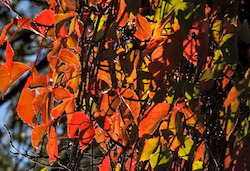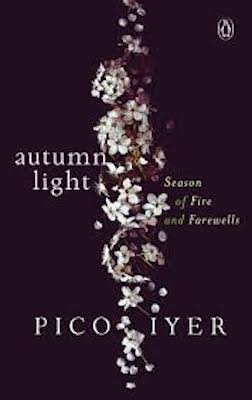
Review by MITA GHOSE
Imprint: India Viking Published: Apr 2019 ISBN: 9780670092215 Length : 248 Pages MRP : ₹599.00
While rereading one of his earlier books on Japan, Pico Iyer had wryly described his younger self as a “smart-aleck know-it-all…passing…sweeping and ignorant judgements on everything”. His latest work reveals how far this globe-trotting journalist and much-acclaimed author has moved from that perspective.
In between came Falling off the Map, his delightfully irreverent take on “some lonely places of the world”, marking his growth and popularity as a writer. But exploring it decades later, I did wonder if Iyer couldn’t have spared a little more room for empathy.

With Autumn Light, he has clearly evolved in that direction. You sense in him a certain tolerance, a deeper understanding of what it is to be human – fears, frailties, warts and all. And in offering new insights into the world he inhabits and especially the one that lies within, he awakens us to our own potential for self-awareness and transformation.
Iyer lends a unique dimension to what is essentially an ode to mortality and transience by examining life in relation to death – perfectly encapsulated in autumn, the season of change and decay – through the prism of Japanese culture. The choice is intuitive, given the author’s natural empathy for the country where this book is primarily based and where he now lives half the year with his wife Hiroko and her adult children from a previous marriage, spending the remaining six months tending to his ageing mother in California’s forest fire-prone Santa Barbara or criss-crossing the globe to report on conflict zones like Mogadishu.
Straddling these disparate worlds – all vulnerable to the vagaries of change – Iyer is best placed, perhaps, to reflect on the true meaning of impermanence, sensing, in the Japanese way, the urgency of holding “on to the things we love even though we know that we and they are dying…to see the world as it is, yet find light within that truth”.
Where else but in a country with the world’s oldest population would such wisdom acquire a special poignancy? Where else but in Japan that has survived many storms – earthquakes, fires, tsunamis, an economic boom-and-bust and most importantly, a devastating war? Unsurprisingly, some of the book’s most haunting vignettes capture moments from the aftermath of World War II – witnessed by the defeated. Consider the case of Hiroko’s father: released from a POW camp in Siberia following Japan’s surrender, he returns to Hiroshima, his atom-bombed hometown, and a grieving mother who refuses to believe that he is, indeed, alive and not the ghost she takes him for. Yet, this battle-scarred man’s childlike enthusiasm about visiting America, the country of his erstwhile enemies, knows no bounds.
Intimations of mortality don’t emanate from the battlefield alone. Hiroko’s daughter Sachi is diagnosed with cancer in early adolescence. She weeps a little, “then…picked up her culture’s sense that an argument with reality is one you’ll never win, and never cried again”. Is such stoicism inevitable in a community where the divisions separating this world from the next are “porous” and Obon, the local Festival of the Dead, is celebrated to welcome the ghosts of the deceased returning to “look in on their loved ones” on earth? Is this the real Japan beneath its sophisticated urban veneer? It’s certainly the one that speaks to Iyer in a language he understands.
Going through the book’s lyrical passages and scenes of determined good cheer (at the local club, for example, which the author frequents for games of ping pong with senior citizens), you do wonder if present-day Japan isn’t being fondly projected as a kind of utopia, with its people apparently capable of finding hope in every situation and soldiering on with “a mingled pang of wistfulness and buoyancy”. But Autumn Light also dwells on the shadows, the unhealed wounds.
Consider Hiroko’s own story. Her brother Masahiro’s cruel rejection of his family is hard to fathom, despite the reason he cites: his sister’s divorce and second marriage to a foreigner. He answers her letters with unrelenting silence, is absent from his father’s funeral and never once visits his dementia-afflicted mother at the hospital. Rendered in Hiroko’s fractured English, her plaintive queries about him – “Where my son? He die?” – are heartbreaking. Yet, there’s the other Masahiro from the past, the sensitive child locked in a closet by his father as punishment for some misdemeanour, crying piteously: “Please let me out! Please! It’s dark and lonely; I’m scared.” We are all prisoners of our inner demons, Iyer suggests, and the escape route is for us to find.
The heart of this book, however, is Hiroko – bold and enterprising on the one hand, caring, sensitive, vulnerable on the other, intensely Japanese, yet unique in the courage she demonstrates by daring to upset the status quo, to live the life she chooses. In that sense, Autumn Light is also a tribute to this inspiring woman.
Readers accustomed to Iyer’s crisp, tightly structured writing may chafe at the book’s free-flowing form and contemplative mood. Yet, his signature is everywhere – in his clarity of insight, leavened with greater wisdom, his humour, turning self-deprecatory, his sense of irony, newly tempered with “the more forgiving and indulgent eye that the years can bring”. Less inclined now to stand out as “a soloist tootling off on his own” and preferring, occasionally, to remain “a voice within a choral symphony”, Iyer seems to have found what most don’t in a lifetime – light within the truth.
(This was first published by Hindu Business Line on 06 Sept 2019 )

Leave a Reply